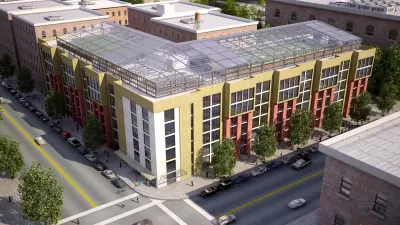After moving forward with parking and zoning reforms, the Berkeley City Council is also considering a new Affordable Housing Overlay on a model previously adopted in Cambridge, Massachusetts.

Berkeley is not resting after taking several significant steps toward planning reform in recent months—first by removing residential parking requirements in most parts of the city and then by voting to rescind single-family zoning.
Berkeley Councilmember Terry Taplin has also sponsored a 100% Affordable Housing Overlay, building on a model provided by a similar overlay approved by Cambridge, Massachusetts in October 2020.
Randy Shaw, who has written on the idea previously for Beyond Chron and in his book Generation Priced Out, details the proposal. Shaw is an obvious proponent of the Affordable Housing Overlay concept, calling it "the best strategy for high housing cost cities to reduce segregation."
How does an affordable housing overlay work? "Cambridge’s Affordable Housing Overlay permits greater height and density for ministerial approval for 100% Below Market-Rate housing developments." Those height and density bonuses "[increase] the availability of infill sites where nonprofit and public entities may otherwise be unable to compete with private developers," according to Shaw, who notes that numerous underutilized commercial parcels in Berkeley would become much more viable for affordable housing development under the proposed changes.
Councilmember Taplin's proposed overlay was scheduled for a hearing before the Berkeley City Council's Land Use Committee on March 4. The Joint Center for Housing Studies at Harvard University is hosting a free webinar on the subject of affordable housing overlays on March 11, exploring the possibility of this planning policy tool's expansion to yet more locations.
FULL STORY: Berkeley's Next Big Step: A 100% Affordable Housing Overlay

Manufactured Crisis: Losing the Nation’s Largest Source of Unsubsidized Affordable Housing
Manufactured housing communities have long been an affordable housing option for millions of people living in the U.S., but that affordability is disappearing rapidly. How did we get here?

Americans May Be Stuck — But Why?
Americans are moving a lot less than they once did, and that is a problem. While Yoni Applebaum, in his highly-publicized article Stuck, gets the reasons badly wrong, it's still important to ask: why are we moving so much less than before?

Using Old Oil and Gas Wells for Green Energy Storage
Penn State researchers have found that repurposing abandoned oil and gas wells for geothermal-assisted compressed-air energy storage can boost efficiency, reduce environmental risks, and support clean energy and job transitions.

Minneapolis Bans Rent-Setting Software
Four cities have enacted restrictions on algorithmic software that can inflate rent costs.

Oakland to Add 244 New EV Chargers
Oakland plans to launch its new charging network at eight locations by the end of 2025.

Jane Goodall Inspires with Message of Hope, Resilience, and Environmental Action
Speaking in Pasadena, Jane Goodall offered a hopeful and inspirational message, urging global compassion, environmental responsibility, and the power of individual action to shape a better future.
Urban Design for Planners 1: Software Tools
This six-course series explores essential urban design concepts using open source software and equips planners with the tools they need to participate fully in the urban design process.
Planning for Universal Design
Learn the tools for implementing Universal Design in planning regulations.
Heyer Gruel & Associates PA
City of Moreno Valley
Institute for Housing and Urban Development Studies (IHS)
City of Grandview
Harvard GSD Executive Education
Salt Lake City
NYU Wagner Graduate School of Public Service
City of Cambridge, Maryland





























